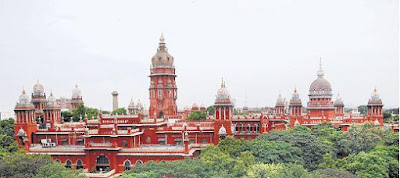 |
| Madras-high-court. en.wikipedia.org |
 |
| Madras-high-court building, Chennai, Tamil Nadu. . www.junglekey.in |
 |
| The Esplanade Road with the Madras High Court on the left. Circa 1905. Photo. www.thehindu.com |
The Madras High Court established on June 26, 1862 as one of the three High Courts of India; others being Bombay and Calcutta. It came into being at Madras (now Chennai) Presidency town by letters Patent granted by Queen Victoria under the authority of the British parliament's Indian High Courts Act 1861. The purpose of the High court here was to expedite the pending civil and criminal cases after India came under the control of British Crown in 1859 from East India British company which became corrupt, repressive and had to handle enormous lands in the Indian sub continent. Sepoy mutiny was yet another reason for the take over of the administration under the direct control of the English Government.
To day the Madras High court stands as a solid monument to the past glory of the British rulers and is an important land mark in this sprawling city. Considered as the second largest judicial complex in the world, it was designed by the well-known British architect Henry Irwin. This impressive edifice is a good example of Indo-Saracenic style of architecture
 |
| The Madras High Court, Tamil Nadu .www.thehindu.com |
There were 59 justices in charge of dispensation of cases and administration of justice. Initially the Supreme Court of Madras functioned from 1862 to 1892 in a building opposite to Beach Railway station. The early judges of the high court included judges Holloway, Innes and Morgan. For a long time only the British subjects were allowed to function as justices. It was one Sir T. Muthuswamy Iyer was the first Indian to be appointed as a justice, later followed by Justices V. Krishnaswamy Iyer and P. R. Sundaram Iyer.
As mentioned above the architect of this unique court building was Henry Irwin who was ably assisted by J. H. Stephens. The building is characteristic of painted ceiling and colored stained glass windows that enhance the beauty and majesty of this historical building. However, the old light house of the city located on the High court complex is poorly maintained and is losing its heritage value. The ruling government ought to do some thing to preserve such heritage building that takes us back to the colonial British era.
A part of the high court building was damaged during the sudden shelling of German war ship S.M.S. Emden on the night of 22 September 1914 at the beginning of WWI. Under the able and chivalrous German Commander Von Muller, Emden shelled at Burmah Shell oil tanks near the shore and set them ablaze.Unfortunately, as the court building happened
 |
| The Madras High Court .www.livelaw.in |
The Madras Hight court has the unique distinction of having the largest number of courts in Asia.
Tit-Bits:
Initially the Indian justices were not allowed to preside over cases involving British subjects and pronounce judgments and such cases were handled by a bench comprising only of British Justices. This caused lots of resentment among Indian justices. This trend continued for a bit of time.
Ref:
https://en.wikipedia.org/wiki/Madras_High_Court









